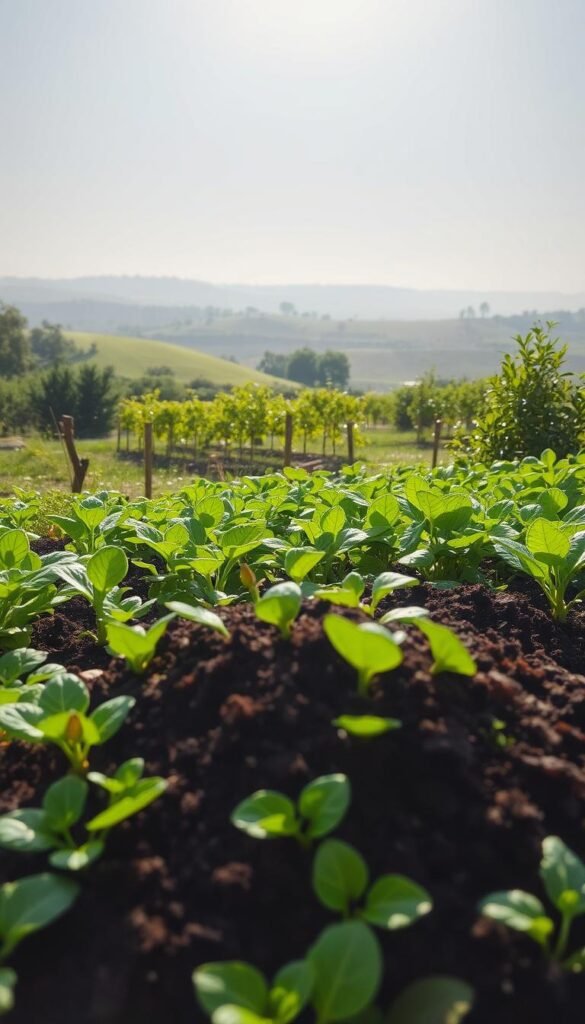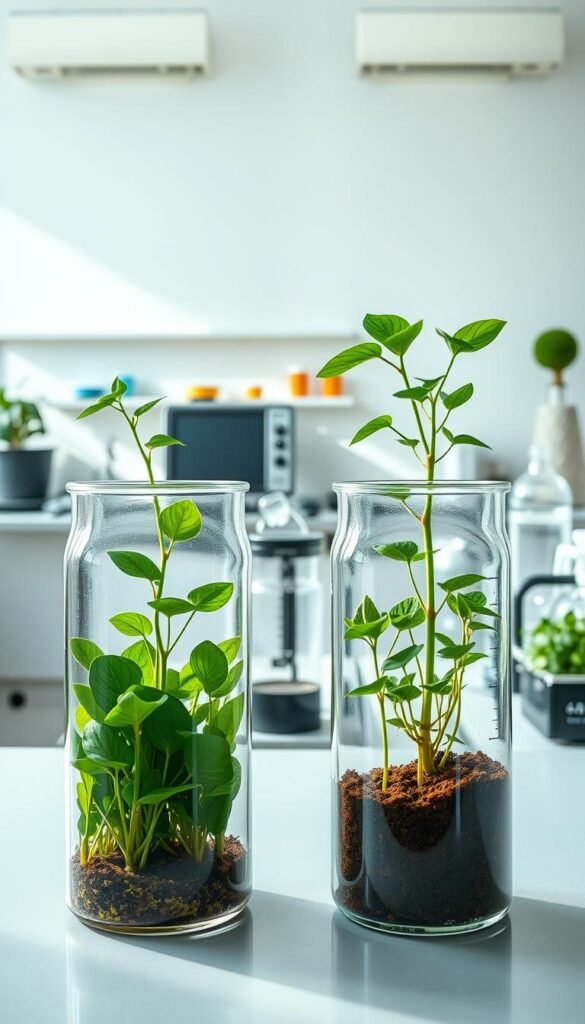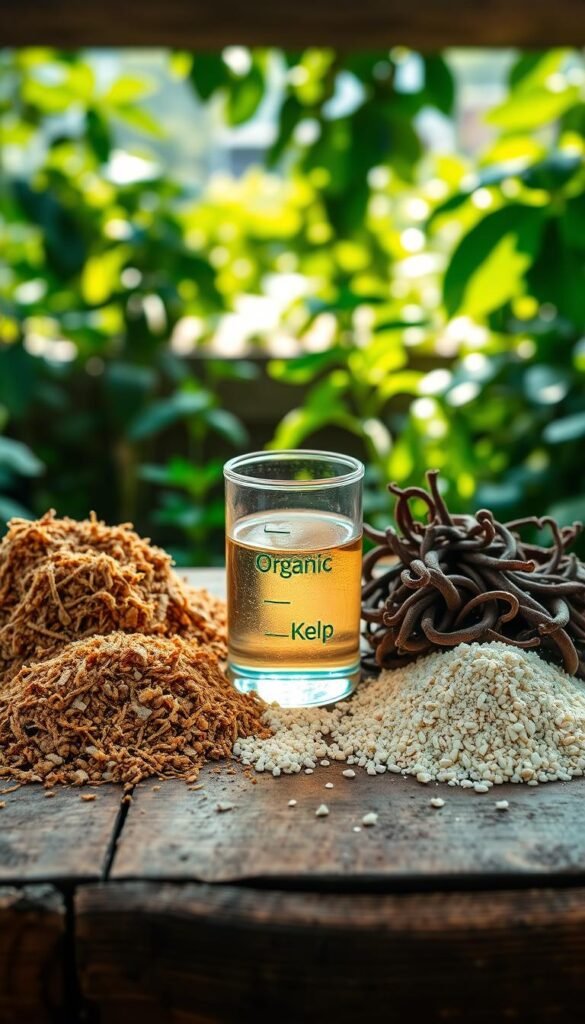Your garden’s success starts beneath the surface. The substances you add to your soil create ripple effects that touch everything from seedling growth to local ecosystems. While all plant foods share the same basic purpose, their origins and impacts couldn’t be more different.
Natural options come from living sources like compost and animal byproducts, feeding plants through gradual breakdown. Manufactured alternatives deliver concentrated nutrition through chemical processes. This fundamental difference shapes how quickly your greens get fed, how soil biology evolves, and what footprints you leave on the environment.
Why does this matter? Fast-acting solutions might save struggling tomatoes today but could weaken your soil’s natural defenses over time. Slower-release choices build resilience while supporting beneficial microbes – crucial for long-term garden health. Your decision even influences water quality, as some formulas resist runoff better than others.
We’ll show you how different nutrient delivery systems affect plant vitality across seasons. Discover when instant results outweigh gradual improvements, and learn how certain gardening methods pair better with specific feeding approaches. You’ll gain practical insights to match your green goals, whether nurturing houseplants or managing acreage.
Understanding Fertilizer Fundamentals

The secret to lush growth lies in balanced nutrition. Three elements form the foundation: nitrogen (N), phosphorus (P), and potassium (K). These NPK nutrients work like a plant’s daily multivitamin, each serving distinct roles in development.
Plant Growth Essentials
Nitrogen fuels leafy expansion but demands careful dosing. Overload it, and you’ll get floppy stems with few blooms. Phosphorus powers root systems and flower production – ideal for new transplants. Potassium acts as the plant’s immune booster, strengthening cell walls against droughts and diseases.
Soil’s Living Network
Your soil teems with microorganisms that process nutrients. These tiny helpers break down compounds into forms roots can absorb. Chemical imbalances disrupt their colonies, while balanced feeding encourages thriving microbial communities.
| Nutrient | Primary Role | Excess Symptoms |
|---|---|---|
| Nitrogen | Leaf growth | Weak stems, delayed flowering |
| Phosphorus | Root development | Leaf discoloration |
| Potassium | Disease resistance | Salt-damaged roots |
Proper feeding maintains this delicate dance between plant needs and soil health. Test your earth regularly – it’s the only way to know what your green friends truly crave.
Diving into Organic Fertilizers

Your plants thrive on more than just water and sunlight—they need a living soil ecosystem. Natural options work differently than quick-fix solutions, feeding roots through teamwork with underground microbes.
Natural Origins and Nutrient Release
These plant foods come from surprising places. Animal bones become phosphorus-rich meals, while seaweed transforms into potassium-packed blends. Even volcanic rocks contribute minerals through slow weathering.
Microbes break down these materials over weeks, releasing nitrogen and other elements gradually. This steady supply matches plant needs without overwhelming delicate roots. It’s like nature’s time-release capsule for greenery.
Benefits for Soil Health and Biodiversity
Every application builds your garden’s foundation. Earth becomes fluffier, holding 40% more water according to recent studies. Worms and beneficial fungi multiply, creating natural pest barriers.
You’ll notice fewer deficiencies thanks to trace elements like zinc. These often-overlooked micronutrients boost flavor in veggies and vibrancy in flowers. For eco-friendly options in container gardens, these slow-release choices shine.
Over seasons, organic matter accumulates like savings in a bank. Your soil becomes richer, needing fewer inputs each year. It’s gardening that grows easier as time passes.
Exploring Synthetic Fertilizers

Plants in distress need quick solutions, and that’s where synthetic options shine. These products act like emergency medicine for your garden, delivering precise nutrition when greenery shows urgent deficiency signs. Their water-soluble formulas bypass soil processes, feeding roots directly within hours.
Rapid Nutrient Delivery and Application Methods
Liquid concentrates and slow-release granules dominate the market. Spray mixes revive yellowing leaves in days, while coated pellets provide steady feeding for up to six weeks. These methods prove invaluable for hydroponic gardening systems requiring precise control over nutrient levels.
| Type | Speed | Duration | Risk Level |
|---|---|---|---|
| Liquid | 24-48 hours | 2 weeks | High (burn risk) |
| Granules | 3-5 days | 4-6 weeks | Moderate |
| Spikes | 7-10 days | 8 weeks | Low |
Potential Environmental and Soil Concerns
Rainstorms wash away excess chemicals into waterways, fueling toxic algae growth. Studies show 40% of applied synthetic nutrients may leach beyond root zones. Over time, soils become compacted and lifeless, losing their natural ability to retain moisture or nutrients.
For gardeners seeking alternatives, combining these products with hydroponic gardening techniques can reduce environmental impact through controlled dosing. Always measure carefully – that vibrant green lawn today could mean dead zones in local ponds tomorrow.
Organic Fertilizers vs. Synthetic: Pros, Cons, and Best Uses

Choosing plant nutrition isn’t just about growth rates—it’s about balancing immediate needs with lasting consequences. Your decision shapes everything from weekly maintenance to your garden’s future resilience.
Head-to-Head: Results and Repercussions
Quick fixes come at a price. Manufactured options deliver nitrogen spikes that green up leaves fast but fade within weeks. Natural alternatives release nutrients over months, like a steady paycheck for your plants.
Costs tell contrasting stories. One bag of natural amendments might equal three chemical applications. But spread that same bag once yearly versus monthly synthetic doses, and long-term math favors earth-friendly choices.
“Soil remembers every treatment—build its health, and it repays you for decades.”
| Factor | Natural Options | Chemical Options |
|---|---|---|
| Cost per year | $50-$80 | $30-$60 |
| Applications needed | 1-2 | 4-6 |
| Nutrient release | 2-6 months | 2-6 weeks |
| Burn risk | Low | High |
| Environmental impact | Minimal | Moderate-High |
New gardeners breathe easier with natural choices. Overdoing it rarely harms plants—microbes regulate uptake. Chemical blends demand precision measuring. One extra scoop could yellow leaves overnight.
Earth quality shifts silently beneath your feet. Regular synthetic use compacts ground over time, reducing water absorption by 25%. Natural matter acts like sponges, cutting irrigation needs while filtering runoff.
Match your pick to the problem. Rescue dying annuals with liquid chemical boosts. Nourish fruit trees and perennial beds with slow-release organic meals. Your soil’s future depends on today’s choices.
Practical Tips for Fertilizer Application

Feeding your plants effectively requires precision, not guesswork. Let’s explore how to nourish greenery without wasting resources or harming your garden’s foundation.
Tailoring Techniques to Your Garden
Young seedlings crave gentle nutrition. Use diluted liquid formulas for delicate roots. Established perennials benefit from granular options worked into their root zones.
Clay-heavy earth holds nutrients longer than sandy plots. Adjust application frequency based on your dirt type. A simple squeeze test reveals moisture retention – wet soil needs less frequent feeding.
Preventing Nutrient Overload
Yellow leaf edges often signal chemical burns. Flush affected areas with water immediately. For granular products, rake away excess granules before watering.
| Fertilizer Type | Best Timing | Application Tools | Safety Check |
|---|---|---|---|
| Liquid | Morning hours | Sprayer with filter | pH test after 48h |
| Granular | Pre-rainfall | Drop spreader | Soil probe check |
| Spikes | Dormant season | Auger tool | Root zone mapping |
Always conduct soil tests before feeding. Penn State Extension reports 60% of home gardens receive unnecessary nutrients. Match NPK ratios to your test results, not package claims.
Water deeply after applications to prevent salt buildup. Use drip irrigation for slow, even distribution. This method reduces runoff by 40% compared to sprinklers.
Combining Organic and Synthetic Approaches
Smart gardeners know secrets aren’t found in extremes. Blending natural amendments with precision-made formulas creates a hybrid feeding plan that addresses both urgent needs and future growth. This balanced strategy helps plants thrive today while building richer earth for tomorrow.
Strategic Layering for Year-Round Vitality
Start with slow-release options like compost during early planting. These work underground to improve soil structure and microbial activity. When crops hit growth spurts, water-soluble formulas deliver instant nourishment without overwhelming roots.
Mid-summer tomatoes begging for potassium? Side-dress with mineral-based blends. Established perennials benefit from autumn mulch applications that break down gradually. This layered approach maintains steady nutrients soil levels while reducing waste through targeted delivery.
Studies show combined systems increase yields by 18% compared to single-method use. Farmers successfully pair manure pre-planting with nitrate boosts during stem elongation. Your backyard thrives using the same principle – feed your plants and nourish the earth simultaneously.






